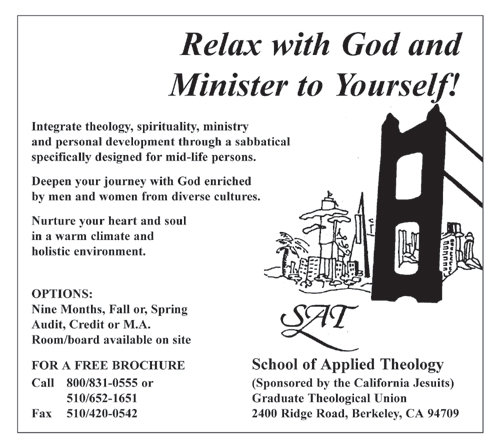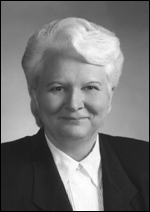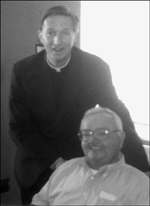 |
| The designers of this ad for the Graduate Theological Union in Berkeley understood precisely the yearnings implicit in seekers’ spirituality.
Click here for larger view of ad. |
Americans’ fascination with spirituality has been escalating dramatically. Despite evidence that churches and synagogues are, on the surface, faring well, the deeper meaning of spirituality seems to be moving in a new direction. Indeed, the foundations of religious tradition seem to be less secure than in the past. Insisting that old phrases are cant, many Americans struggle to invent new languages to describe their faith. As they do, their beliefs are becoming more eclectic, and their commitments are often becoming more private.
At the start of the twentieth century, virtually all Americans were cradle-to-grave members of their particular traditions, and their spirituality prompted them to attend services and to believe in the teachings of their churches and synagogues. Now, growing numbers of Americans piece together their faith like a patchwork quilt.
The former way, a spirituality of dwelling, emphasizes habitation. God occupies a definite place in the universe and creates a sacred space in which humans too can dwell; to inhabit sacred space is to know its territory and to feel secure. The latter way, a spirituality of seeking, emphasizes negotiation: individuals search for sacred moments that reinforce their conviction that the divine exists, but these moments are fleeting; rather than knowing the territory, people explore new spiritual vistas, and they may have to negotiate among complex and confusing meanings of spirituality.
The one form of spirituality is not entirely new, nor is the other completely out of vogue. Settled times have been conducive to an imagery of dwellings; unsettled times, to an imagery of journeys. In one, the sacred is fixed, and spirituality can be found within the gathered body of God’s people; in the other, the sacred is fluid, portable, and spirituality must be pursued with a sense of God’s people having been dispersed.
A spirituality of dwelling requires sharp symbolic boundaries to protect sacred space from its surroundings; a spirituality of seeking draws fewer distinctions of such magnitude. Rather than being in a place that is by definition spiritual, the sacred is found momentarily in experiences as different as mowing the lawn or viewing the full moon.
The Wisdom of Saint Benedict
The contrast between these two kinds of spirituality is evident in the sixth-century Rule of Saint Benedict, which asks monks to take vows of stability, conversatio, and obedience. Stability emphasizes settledness; conversatio, change; and obedience suggests a need for commitment to both. Some interpretations associate stability with a commitment to a local orientation that resists searching for greener pastures elsewhere. Conversatio is more difficult to interpret. It connotes the changeable life of the spirit, especially the ephemeral qualities of the Holy Spirit. Conversatio is a commitment to live faithfully in unsettled times and to keep one’s life sufficiently unsettled to respond to the changing voice of God. It emphasizes vulnerability as a basic fact of the human condition and mystery as a characteristic of the sacred.
The wisdom of Saint Benedict is that dwelling and seeking are both part of what it means to be human. The desire for dwelling is evident in the fact humans build temples and construct altars as places to worship. Equally strong is the human desire to be part of an unfolding process, to negotiate, to be on the road, to experience novelty, and to grow.
What is at issue is the nature of institutions where the resources on which individuals rely for their ideas about the sacred are shaped. Paying attention to the relative emphasis on dwelling and on seeking, and to the social conditions that reinforce these orientations, is thus a way of clarifying how dominant understandings of spirituality have been changing.
There are many ways of experiencing the shift from dwelling to seeking. For some, the shift is experienced as living no longer within a sacred space but between sacred spaces. At one time, people identified their faith by membership; now they do so increasingly by the search for connection with various organizations and groups, all the while feeling marginal to any particular group or place.
For some people, the shift is analogous to changes that have taken place in the economy. They no longer depend primarily on producing durable goods; instead, they produce services and information. In their faith, they once relied heavily on bricks and mortar, on altars, and on gods who called them to dwell eternally in sacred places. Now they concentrate on information flows—ideas that may help with the particular needs they have at the moment but that do not require permanent investments of resources. Other people experience change as a shift from spiritual production to spiritual consumption. They now let professional experts—writers, artists, therapists, spiritual guides—be the producers while they consume what they need in order to enrich themselves spiritually. Faith is no longer something people inherit but something for which they strive.
Americans experience this transition as a combination of past realities and present possibilities. Spirituality is an assortment of activities and interpretations that reflect the past, that include new ways of understanding the past, and that envision something distinctly different. People do not simply abandon the quest for a spiritual home but rethink what such a home may mean now that they feel spiritually homeless. They use the faith of their parents and grandparents as ways to identify their own, if only in contrast.
Confronting Secularity
A spirituality of inhabiting emphasizes an orderly, systematic understanding of life. A spirituality of journeying is less likely to generate grand conceptions of the universe and more likely to invoke a pragmatic attitude. Implicitly, this shift consists of movement away from a denial of doubt to a redefinition of doubt as the essence of reality.
For many, the new understandings of spirituality seem frightening and chaotic. When the sacred no longer has a single address, people worry that it may disappear entirely. Secularity seems on the verge of winning. Many people remain convinced of God’s existence but realize increasingly that the reality of their world is secular.
Much of Americans’ current religious behavior can be understood as a result of this new confrontation with secularity. Some people revel in the fact that God is silent; some thrash about wildly in their attempt to rediscover the sacred; and some dig in their heels, arguing all the harder for the importance of older ways of understanding the sacred. Americans are not marching steadfastly into a secular age but are reshaping deep religious traditions in ways that help make sense of the new realities of their lives. Americans are not simply people of faith who need to get religion back into the public life of their country; they are often confused individuals who are interested in spirituality but are unable to let organized religion solve all their problems.
Broad uncertainties are only part of the story. The religion industry is also responsible for the transformation that is taking place. Religious leaders were eager to make spirituality popular, to keep it relevant, and to adapt to changing times. They became entrepreneurs. They learned how to market religion, and they taught the faithful to become consumers. In recent decades, the religion industry has experienced a significant expansion, and the boundaries between it and other industries have become blurred. It is not surprising, therefore, that people shop for spirituality and that they do so in an increasing variety of ways.
Another factor is the “conversation with our past.” People compare themselves with their parents, making assumptions about what their parents believed and defining themselves in relation to those assumptions. If earlier generations found solace in a spirituality of inhabiting, people now take pride in the fact that they are seekers.
A Look at Past Events
The shift I describe has been shaped by historical events. Until World War II, ethnic groups were still influenced predominantly by their immigrant experience. They came in search of a better life, of a home—physically and spiritually. After the war, Americans returned feverishly to the task of building their various homes. If Levittown symbolized the new spate of homebuilding in the suburbs, the Cold War symbolized Americans’ concern to have a safe nation in which to live, and the growth of churches and synagogues supplied a similar emphasis in spirituality. But the 1950s were to be an ending as much as a beginning. The 1960s forcefully created the realization that things were not so easily controlled. Institutions were being questioned, as was the identity of the nations. Religious leaders declared that God was dead. And new religious leaders rose up to take their place.
After a decade of unrest, Americans were desperate to return to the past. As best they could, they rediscovered their conservative heritage and their evangelical Christian or orthodox Jewish roots. But increasingly they realized that returning to the past was impossible.
Since the 1960s, a quiet change has also been taking place in matters of the heart, including the ways many Americans define themselves. Growing numbers of people have undergone therapy and participated in support groups that have encouraged them to rethink who they are. Best-selling authors have counseled millions to get in touch with their inner selves. Religious leaders have run hard trying to keep up. A majority of the public has retained some loyalty to their churches and synagogues, yet their practice of spirituality from Monday to Friday often bears little resemblance to the preachments of religious leaders.
Challenge of New Understandings
Like any such transition, this one has generated a great deal of collective anxiety. The newer understandings of spirituality are both liberating and frightening because they require people to do more of the work needed to understand spirituality and to put it into practice.
Certainly, however, the transformation of American spirituality poses new challenges for the public life of the nation as well as for individual lives. A great debate has erupted over the fate of religious values in our society. Behind the question of religion’s influence is the issue of what religion is, not to mention what it should be. Do we cultivate spirituality in our personal lives? Does it shape the way we think and feel and behave? Are our children seeing how it influences us? Are we stronger, more virtuous, and of deeper character as a result?
I believe the United States is moving into an era of what might be termed a “thin consensus,” in which relatively few values are held in common. Most Americans may cherish democracy, fairness, and family, but they hold widely different views about what these terms mean. More important, because people have fluid identities as selves and as spiritual beings, they readily change their minds. Many also wonder how much they can trust themselves and their leaders if their minds are constantly in flux.
Interest in spirituality will not wane, but it will be increasingly difficult to determine precisely what spirituality means. People will need to spend more time than ever before reflecting on the deep values that make life worth living and the sources of those values, including spirituality. They will need to work hard at sifting through the many messages available about spirituality.
Dwelling-oriented spirituality is likely to remain an appealing alternative for many Americans, and religious leaders who promise secure spaces in which to worship God in familiar ways and to pursue personal happiness will be able to attract sizable audiences. For them, the congregation’s mission will be to provide a safe haven. Such leaders will need to draw distinctions between sacred space and profane world, calling God’s people to live apart from the world as a community, a family, a remnant.
But seeker-oriented spirituality will be more compatible than dweller-oriented spirituality with the changing lives that growing numbers of Americans are leading, offering them freedom to make their own choices about how to understand the sacred and exposing them to a variety of ways to worship. Many of these people will continue to find established religious organizations attractive, at least as one path for pursuing spirituality. For seeker-oriented spirituality, however, the congregation functions as a supplier of spiritual goods and services. Large congregations offer a wide variety of goods and services, luring customers to come and to attend often in search of different gratifications. Smaller congregations function more as boutiques, becoming very good at something special, such as a ministry to the homeless, music, or sponsorship of a peace coalition. In this mode, the congregation’s mission is to expand its conception of itself, deploying the clergy as resources and developing networks that link together a wide variety of supportive organizations. Larger entities such as denominations will continue to be one of these networks.
Practice-Oriented Spirituality
Yet neither of these styles is entirely satisfactory, nor is it enough to argue that individuals must simply find some way to combine both. Habitation spirituality encourages dependence on communities that are inherently undependable and fosters an idolization of particular places to the point that energies gravitate too much to those places. A spirituality of seeking, in contrast, is invariably too fluid to provide individuals with the social support they need or to encourage the stability and dedication required to grow spiritually and to mature in character. It was not without reason that the Rule of Saint Benedict emphasized obedience rather than stability or conversatio alone.
The ancient wisdom that emphasizes the idea of spiritual practices needs to be rediscovered; indeed, a practice-oriented spirituality should be considered seriously as an alternative both to dwelling and to seeking. Spiritual practices put responsibility squarely on individuals to spend time on a regular basis worshiping, communing with, listening to, and attempting to understand the ultimate source of sacredness in their lives. They can be performed in the company of others, and they are inevitably embedded in religious institutions, but they must also be performed individually if they are to be personally meaningful and enriching. Spiritual practices require individuals to engage reflectively in a conversation with their past, examining who they have been, how they have been shaped, and where they are headed. Spiritual practices have a moral dimension, for they instruct people in how they should behave toward themselves and with each other, but these practices are also an item of faith, encouraging people to walk each day with partial knowledge and in cautious hope.
Spiritual practice is a way of retrieving the neglected middle in our understandings of religion. The quality of the faith of people who engage in these practices is to be judged by the seriousness of time spent in worshipful communion with the divine and in the consequences for the rest of their lives.
Practice-oriented spirituality preserves some of what has always attracted people to a spirituality of dwelling, for it too requires the setting aside of a space in which to meditate, to pray, and to worship, and in the confusion of everyday life such a space may be possible only by carefully demarcating it from its surroundings. Yet these spaces are negotiable, changeable, and the point of engaging in spiritual practice is not merely to feel secure in a sacred space but to grow increasingly aware of the mysterious and transcendent aspects of the sacred as well. Practice-oriented spirituality makes full use of opportunities for personal exploration, but it is also a way of imposing discipline. Above all, practice requires responsibility on the part of the individual practitioner rather than on the part of some community or the marketplace.
Nurturing a Middle Way
Practice-oriented spirituality can best be nurtured by practice-oriented religious organizations—that is, by churches, synagogues, mosques, temples, and other places of worship that define their primary mission as one of strengthening the spiritual discipline of their members. Such organizations will strive to give members, in J. B. McDaniel’s phrase, both roots and wings—roots to ground them solidly in the traditions of their particular faith, wings to explore their own talents and the mysteries of the sacred. In spiritual practice, religious institutions need to be conceived as facilitators rather than as ends in themselves. They need to send people out to do God’s work in the world. In this view, clergy must serve as models of spirituality, rather than as guardians or shopkeepers.
An emphasis on spiritual practice is also a way of retrieving balance in the contemporary debate over the future of American democracy. For some, the solution to contemporary social ills is to chastise U.S. culture for its individualism, calling for a return to an idealized community that encourages loyalty, self-sacrifice, and civic responsibility. For others, the solution has been to assert the priority of fairness, rights, social justice, and strong institutions capable of protecting individual freedom. The one solution errs in demeaning the individual and in valorizing largely unworkable notions of community; the other overemphasizes rationality and social programs. Spiritual practice invokes the tradition of hard work, individual initiative, and responsible civic participation. In emphasizing the need to reflect and to deliberate on the ultimate sources of one’s moral commitments, this tradition denies that either communities or legal systems have all the answers and insists that effort must be devoted to questions of value if one is to live more than a mediocre existence. The facile shopping for quick-fix solutions to spiritual problems has not served the United States well nor has the hope that people could simply settle into a spiritual community that would solve their problems. An important part of what must be done, therefore, is to recover an understanding of both the value and urgency of spiritual practice.
This article has been abridged from Robert Wuthnow, After Heaven: Spirituality in America since the 1950s (Berkeley, California, University of California Press, 1998). 1998 by The Regents of the University of California; reprinted with permission.



























